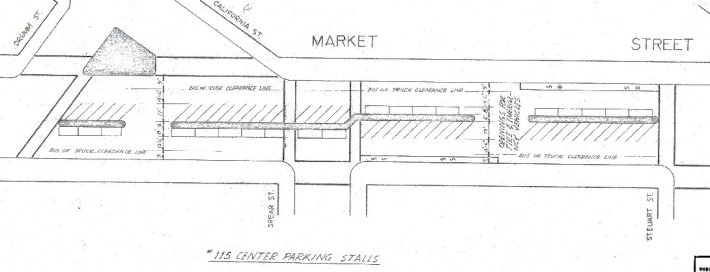
In an alternate universe, the streetcar tracks that line the center of Market Street would have become car parking.
That was an actual proposal in 1954, put forward by Supervisor Marvin Lewis. The plan [PDF] was recently dug up by SFMTA staff from the agency's archives. Today it's an appalling idea, but back then it was typical. The conventional wisdom among city planners and elected officials held that the answer to traffic congestion in downtown SF was to tear it apart with freeways and parking spaces.
While the plan to turn Market into a parking lot was never realized, the pursuit of abundant parking left its mark on downtown SF. The dense urban core is dotted with massive parking garages, including the world's first underground parking structure, under Union Square. It could have been worse -- the Fifth and Mission Garage, for example, was envisioned to be five blocks long, with exterior car ramps.
San Francisco, perhaps more than any other U.S city, successfully resisted many of those would-be disasters. The city's identity would be very different today if SF had torn up its neighborhoods and iconic streets, like Market, to create parking lots.
While SF fought off the worst impulses of 1950s-era thinking, the plan for Market Street is a reminder that for all the "bullets we've dodged," as one SF planner put it, players at City Hall were indeed able to dramatically reshape the city around the car.
Our streets are shaped by deliberate public policy decisions, and the way they are currently designed is not the natural order of things. Every curbside parking spot that opponents of change cling to so fiercely today was at one point bestowed by policy makers, who decided to reallocate street space from general public use to private car owners.
As we revisit streets like Market in 2015, let's remember: It's an era for new possibilities.






